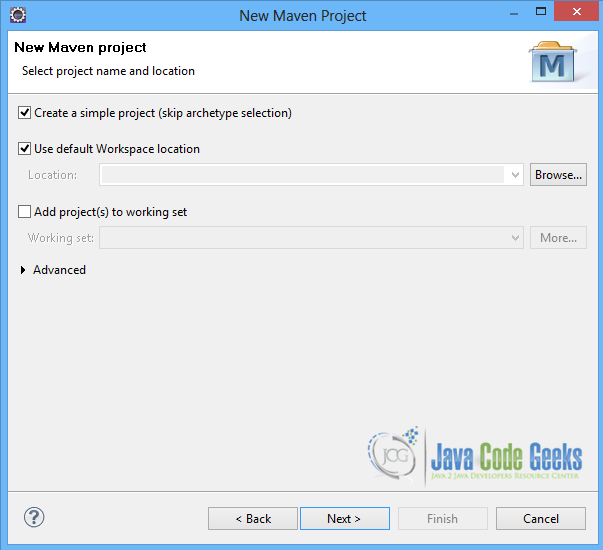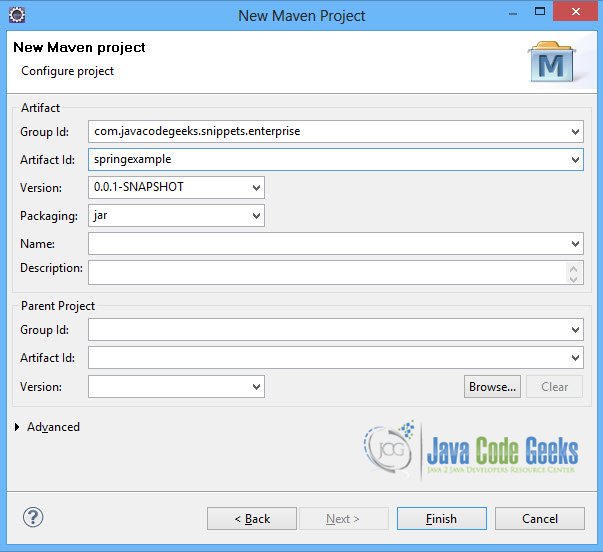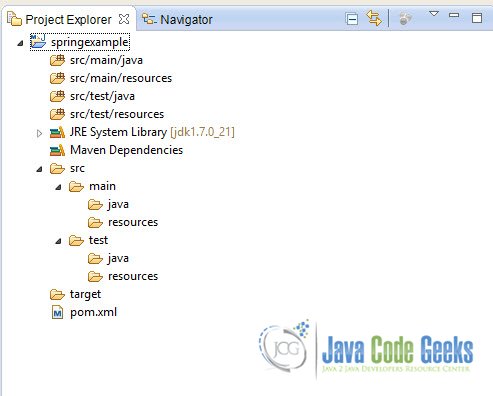Spring 3 Bean Reference Example
With this example we shall show you how to create bean references, using either annotations or xml configuration in Spring 3.2.3. In Spring, a bean can have references to other beans. The Spring container validates the configuration of each bean as the container is created, including the validation of whether bean reference properties refer to valid beans. However, the bean properties themselves are not set until the bean is actually created.
Our preferred development environment is Eclipse. We are using Eclipse Juno (4.2) version, along with Maven Integration plugin version 3.1.0. You can download Eclipse from here and Maven Plugin for Eclipse from here. The installation of Maven plugin for Eclipse is out of the scope of this tutorial and will not be discussed. We are also using Spring version 3.2.3 and the JDK 7_u_21.
Let’s begin.
1. Create a new Maven project
Go to File -> Project ->Maven -> Maven Project.
In the “Select project name and location” page of the wizard, make sure that “Create a simple project (skip archetype selection)” option is checked, hit “Next” to continue with default values.
In the “Enter an artifact id” page of the wizard, you can define the name and main package of your project. We will set the “Group Id” variable to "com.javacodegeeks.snippets.enterprise" and the “Artifact Id” variable to "springexample". The aforementioned selections compose the main project package as "com.javacodegeeks.snippets.enterprise.springexample" and the project name as "springexample". Hit “Finish” to exit the wizard and to create your project.
The Maven project structure is shown below:
- It consists of the following folders:
- /src/main/java folder, that contains source files for the dynamic content of the application,
- /src/test/java folder contains all source files for unit tests,
- /src/main/resources folder contains configurations files,
- /target folder contains the compiled and packaged deliverables,
- the pom.xml is the project object model (POM) file. The single file that contains all project related configuration.
2. Add Spring 3.2.3 dependency
- Locate the “Properties” section at the “Overview” page of the POM editor and perform the following changes:
Create a new property with name org.springframework.version and value 3.2.3.RELEASE. - Navigate to the “Dependencies” page of the POM editor and create the following dependencies (you should fill the “GroupId”, “Artifact Id” and “Version” fields of the “Dependency Details” section at that page):
Group Id : org.springframework Artifact Id : spring-web Version : ${org.springframework.version}
Alternatively, you can add the Spring dependencies in Maven’s pom.xml file, by directly editing it at the “Pom.xml” page of the POM editor, as shown below:
pom.xml:
<project xmlns="http://maven.apache.org/POM/4.0.0"; xmlns:xsi="http://www.w3.org/2001/XMLSchema-instance"
xsi:schemaLocation="http://maven.apache.org/POM/4.0.0 http://maven.apache.org/xsd/maven-4.0.0.xsd">
<modelVersion>4.0.0</modelVersion>
<groupId>com.javacodegeeks.snippets.enterprise</groupId>
<artifactId>springexample</artifactId>
<version>0.0.1-SNAPSHOT</version>
<dependencies>
<dependency>
<groupId>org.springframework</groupId>
<artifactId>spring-core</artifactId>
<version>${spring.version}</version>
</dependency>
<dependency>
<groupId>org.springframework</groupId>
<artifactId>spring-context</artifactId>
<version>${spring.version}</version>
</dependency>
</dependencies>
<properties>
<spring.version>3.2.3.RELEASE</spring.version>
</properties>
</project>
As you can see Maven manages library dependencies declaratively. A local repository is created (by default under {user_home}/.m2 folder) and all required libraries are downloaded and placed there from public repositories. Furthermore intra – library dependencies are automatically resolved and manipulated.
3. Create a simple Spring bean with reference to other beans
We create a simple Spring bean, HelloWorld and add a reference to bean Foo and another reference to bean Bar.
HelloWorld.java:
package com.javacodegeeks.snippets.enterprise.services;
import org.springframework.beans.factory.annotation.Autowired;
import org.springframework.stereotype.Service;
@Service("helloWorldBean")
public class HelloWorld {
@Autowired
private Foo foo;
@Autowired
private Bar bar;
public void setFoo(Foo foo) {
this.foo = foo;
}
public void setBar(Bar bar) {
this.bar = bar;
}
public String toString(){
return " HelloWorld! \n " + foo + "\n and " + bar;
}
}
Foo.java:
package com.javacodegeeks.snippets.enterprise.services;
import org.springframework.stereotype.Service;
@Service("fooBean")
public class Foo {
public Foo(){
}
public String toString(){
return "I am foo " ;
}
}
Bar.java:
package com.javacodegeeks.snippets.enterprise.services;
import org.springframework.stereotype.Service;
@Service("barBean")
public class Bar {
public Bar(){
}
public String toString(){
return "I am bar " ;
}
}
Note that the @Autowired annotation is used, so that the Spring container can autowire relationships between collaborating beans without using constructor-arg and property elements, which helps cut down on the amount of XML configuration you write for a big Spring based application.
Here autowiring by property name is used. Spring container looks at the properties of the beans on which autowire attribute is set to byName in the XML configuration file. It then tries to match and wire its properties with the beans defined by the same names in the configuration file.
The configuration file is shown below:
applicationContext.xml:
<beans xmlns="http://www.springframework.org/schema/beans" xmlns:xsi="http://www.w3.org/2001/XMLSchema-instance" xmlns:p="http://www.springframework.org/schema/p" xmlns:aop="http://www.springframework.org/schema/aop" xmlns:context="http://www.springframework.org/schema/context" xmlns:jee="http://www.springframework.org/schema/jee" xmlns:tx="http://www.springframework.org/schema/tx" xmlns:task="http://www.springframework.org/schema/task" xsi:schemaLocation="http://www.springframework.org/schema/aop http://www.springframework.org/schema/aop/spring-aop-3.2.xsd http://www.springframework.org/schema/beans http://www.springframework.org/schema/beans/spring-beans-3.2.xsd http://www.springframework.org/schema/context http://www.springframework.org/schema/context/spring-context-3.2.xsd http://www.springframework.org/schema/jee http://www.springframework.org/schema/jee/spring-jee-3.2.xsd http://www.springframework.org/schema/tx http://www.springframework.org/schema/tx/spring-tx-3.2.xsd http://www.springframework.org/schema/task http://www.springframework.org/schema/task/spring-task-3.2.xsd"> <context:annotation-config/> </beans>
4. XML-based approach for bean references
Now we are going to demonstrate how to configure Spring bean references directly to the applicationContext.xml file, removing all @Service and @Autowired annotations.
In order to create a reference to the beans of Bar and Foo in HelloWorld, the ref element is used in the helloWorldBean definition. This is the element where we set the value of the specified property of the bean that will be a reference to the helloWorlBean. Scoping and validation depend on whether you specify the id/name of the other object through the bean or local attributes.
4.1 Add reference to a bean in the same xml file
When we specify the bean to which the reference is created through the local attribute, the XML parser validates XML id references within the same xml file. The value of the local attribute must be the same as the id attribute of the target bean. The barBean is referenced using the local attribute, since it is defined in the same file as HelloWorldBean, as shown below:
applicationContext.xml:
<beans xmlns="http://www.springframework.org/schema/beans" xmlns:xsi="http://www.w3.org/2001/XMLSchema-instance" xmlns:p="http://www.springframework.org/schema/p" xmlns:aop="http://www.springframework.org/schema/aop" xmlns:context="http://www.springframework.org/schema/context" xmlns:jee="http://www.springframework.org/schema/jee" xmlns:tx="http://www.springframework.org/schema/tx" xmlns:task="http://www.springframework.org/schema/task" xsi:schemaLocation="http://www.springframework.org/schema/aop http://www.springframework.org/schema/aop/spring-aop-3.2.xsd http://www.springframework.org/schema/beans http://www.springframework.org/schema/beans/spring-beans-3.2.xsd http://www.springframework.org/schema/context http://www.springframework.org/schema/context/spring-context-3.2.xsd http://www.springframework.org/schema/jee http://www.springframework.org/schema/jee/spring-jee-3.2.xsd http://www.springframework.org/schema/tx http://www.springframework.org/schema/tx/spring-tx-3.2.xsd http://www.springframework.org/schema/task http://www.springframework.org/schema/task/spring-task-3.2.xsd"> <bean id="helloWorldBean" class="com.javacodegeeks.snippets.enterprise.services.HelloWorld"> <property name="bar" > <ref local="barBean"/> </property> </bean> <bean id="barBean" class="com.javacodegeeks.snippets.enterprise.services.Bar"> </bean> </beans>
4.2 Add reference to a bean defined in different xml file
When we specify the bean to which the reference is created through the bean attribute of the ref tag, the creation of the bean reference in the same or parent container is accomplished, regardless of whether the bean is in the same XML file. The value of the bean attribute may be the same as the id attribute of the target bean, or as one of the values in the name attribute of the target bean. Since the fooBean is defined in a different configuration file, we use the bean attribute in its reference in helloWorldBean, as shown below:
applicationContext.xml:
<beans xmlns="http://www.springframework.org/schema/beans"
xmlns:xsi="http://www.w3.org/2001/XMLSchema-instance" xmlns:p="http://www.springframework.org/schema/p"
xmlns:aop="http://www.springframework.org/schema/aop" xmlns:context="http://www.springframework.org/schema/context"
xmlns:jee="http://www.springframework.org/schema/jee" xmlns:tx="http://www.springframework.org/schema/tx"
xmlns:task="http://www.springframework.org/schema/task" xsi:schemaLocation="http://www.springframework.org/schema/aop http://www.springframework.org/schema/aop/spring-aop-3.2.xsd http://www.springframework.org/schema/beans http://www.springframework.org/schema/beans/spring-beans-3.2.xsd http://www.springframework.org/schema/context http://www.springframework.org/schema/context/spring-context-3.2.xsd http://www.springframework.org/schema/jee http://www.springframework.org/schema/jee/spring-jee-3.2.xsd http://www.springframework.org/schema/tx http://www.springframework.org/schema/tx/spring-tx-3.2.xsd http://www.springframework.org/schema/task http://www.springframework.org/schema/task/spring-task-3.2.xsd">
<bean id="helloWorldBean"
class="com.javacodegeeks.snippets.enterprise.services.HelloWorld">
<property name="foo" >
<ref bean="fooBean"/>
</property>
<property name="bar" >
<ref local="barBean"/>
</property>
</bean>
<bean id="barBean" class="com.javacodegeeks.snippets.enterprise.services.Bar">
</bean>
</beans>
foo.xml:
<beans xmlns="http://www.springframework.org/schema/beans" xmlns:xsi="http://www.w3.org/2001/XMLSchema-instance" xmlns:p="http://www.springframework.org/schema/p" xmlns:aop="http://www.springframework.org/schema/aop" xmlns:context="http://www.springframework.org/schema/context" xmlns:jee="http://www.springframework.org/schema/jee" xmlns:tx="http://www.springframework.org/schema/tx" xmlns:task="http://www.springframework.org/schema/task" xsi:schemaLocation="http://www.springframework.org/schema/aop http://www.springframework.org/schema/aop/spring-aop-3.2.xsd http://www.springframework.org/schema/beans http://www.springframework.org/schema/beans/spring-beans-3.2.xsd http://www.springframework.org/schema/context http://www.springframework.org/schema/context/spring-context-3.2.xsd http://www.springframework.org/schema/jee http://www.springframework.org/schema/jee/spring-jee-3.2.xsd http://www.springframework.org/schema/tx http://www.springframework.org/schema/tx/spring-tx-3.2.xsd http://www.springframework.org/schema/task http://www.springframework.org/schema/task/spring-task-3.2.xsd"> <bean id="fooBean" class="com.javacodegeeks.snippets.enterprise.services.Foo"> </bean> </beans>
5. Run the application
Through the ApplicationContext the beans are loaded to App.class.
App.java:
package com.javacodegeeks.snippets.enterprise;
import org.springframework.context.ApplicationContext;
import org.springframework.context.support.ClassPathXmlApplicationContext;
import com.javacodegeeks.snippets.enterprise.services.HelloWorld;
public class App {
@SuppressWarnings("resource")
public static void main(String[] args) {
ApplicationContext context = new ClassPathXmlApplicationContext(new String[] {"applicationContext.xml", "foo.xml"});
HelloWorld helloWorld = (HelloWorld) context.getBean("helloWorldBean");
System.out.println(helloWorld);
}
}
6. Output
When you execute the application you should see something like the output presented below:
HelloWorld!
I am foo
and I am bar
Download the Eclipse project of this part : springBeanReference.zip
This was an example of how to create Bean Reference with annotations or with XML configuration in Spring 3.2.3.







